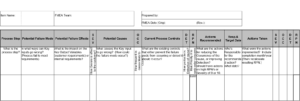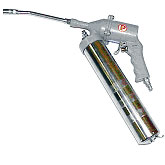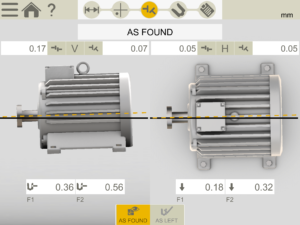How to use FMECA to drive reliability improvements in your organization
 An important part of the Reliability Centered Maintenance process, or used as a standalone approach for less critical assets; the Failure Mode Effect Criticality Analysis is vital reliability tool. However, a large percentage of organizations do not take advantage of the tool during the design phase of the asset, or to develop the maintenance strategy once the asset is installed.
An important part of the Reliability Centered Maintenance process, or used as a standalone approach for less critical assets; the Failure Mode Effect Criticality Analysis is vital reliability tool. However, a large percentage of organizations do not take advantage of the tool during the design phase of the asset, or to develop the maintenance strategy once the asset is installed.
[Read more…]
 Determining which parts of stock can be a very overwhelming process. As such, many choose to blindly accept the OEM or Manufacturer’s recommendations. And why shouldn’t they? The OEM has many years of experience in building these types of assets and supplying spares, right?
Determining which parts of stock can be a very overwhelming process. As such, many choose to blindly accept the OEM or Manufacturer’s recommendations. And why shouldn’t they? The OEM has many years of experience in building these types of assets and supplying spares, right?

 Lubrication is often overlooked in organizations. Why it is overlooked, I am unsure. Maybe it is because it is considered to be a basic job, given to the apprentice, or it is just too simple to not to do it correctly.
Lubrication is often overlooked in organizations. Why it is overlooked, I am unsure. Maybe it is because it is considered to be a basic job, given to the apprentice, or it is just too simple to not to do it correctly. I can remember the first time I was told to grease a bearing. I ask the millwright “How do I know when there is enough grease?”. He responded, ” When you see it come out of the sides of the bearing”… How many of you had this same experience?
I can remember the first time I was told to grease a bearing. I ask the millwright “How do I know when there is enough grease?”. He responded, ” When you see it come out of the sides of the bearing”… How many of you had this same experience? Almost all maintenance, reliability or asset management professionals have heard of reliability engineering. But what is reliability engineering? A quick google search will return the following definition “Reliability Engineering is engineering that emphasizes dependability in the lifecycle management of a product. Dependability, or reliability, describes the ability of a system or component to function under stated conditions for a specified period of time.”
Almost all maintenance, reliability or asset management professionals have heard of reliability engineering. But what is reliability engineering? A quick google search will return the following definition “Reliability Engineering is engineering that emphasizes dependability in the lifecycle management of a product. Dependability, or reliability, describes the ability of a system or component to function under stated conditions for a specified period of time.” What does the word statistics bring to mind when you hear it? Horrible high school classes that you sat through wondering why do I need this stuff? Complex math problems what were almost impossible to figure out? Or is it nonsense that
What does the word statistics bring to mind when you hear it? Horrible high school classes that you sat through wondering why do I need this stuff? Complex math problems what were almost impossible to figure out? Or is it nonsense that  How many times has an asset been installed or commissioned, only to have it fail in a few days or months when it should have lasted even longer? If you look at the study by Nowlan & Heap, they have found that only 11% of failures are age related, so when is happening with these assets? The answer… comes down to poor installation practices.
How many times has an asset been installed or commissioned, only to have it fail in a few days or months when it should have lasted even longer? If you look at the study by Nowlan & Heap, they have found that only 11% of failures are age related, so when is happening with these assets? The answer… comes down to poor installation practices. A major asset is being installed, and the asset is vital to the success of a brand new, high-profit product being introduced to the site. This product is enough to keep the site operational for many years to come. The installation of the asset is critical, and there is extensive prep work to eliminate
A major asset is being installed, and the asset is vital to the success of a brand new, high-profit product being introduced to the site. This product is enough to keep the site operational for many years to come. The installation of the asset is critical, and there is extensive prep work to eliminate  As the kids go back to school, maintenance, reliability, and asset management professional resume their professional learning. This learning usually takes place at one of the numerous world-class conferences available across North America and internationally. These conferences allow professionals to observe and connect with the latest tools, technology, and techniques in our amazing profession.
As the kids go back to school, maintenance, reliability, and asset management professional resume their professional learning. This learning usually takes place at one of the numerous world-class conferences available across North America and internationally. These conferences allow professionals to observe and connect with the latest tools, technology, and techniques in our amazing profession. The first step to any reliability improvement program is to define what data or information will be required to drive defect elimination. In the previous posts, the following topics were discussed;
The first step to any reliability improvement program is to define what data or information will be required to drive defect elimination. In the previous posts, the following topics were discussed; As maintenance, reliability, and asset management professionals, we are in an amazing time. We can collect virtually limitless amounts of data on the condition of our assets. With this data, we can determine the exact condition of the assets, predict when the next failure is likely to occur and how it will occur. Besides, with all of this data, we can move to prescriptive maintenance, where the maintenance actions are determined based on the asset condition, not a predetermined strategy. I’ll touch more on prescriptive maintenance in next week’s post.
As maintenance, reliability, and asset management professionals, we are in an amazing time. We can collect virtually limitless amounts of data on the condition of our assets. With this data, we can determine the exact condition of the assets, predict when the next failure is likely to occur and how it will occur. Besides, with all of this data, we can move to prescriptive maintenance, where the maintenance actions are determined based on the asset condition, not a predetermined strategy. I’ll touch more on prescriptive maintenance in next week’s post. 
 To increase your knowledge, you need to learn new things, try new things and generally push outside of your comfort zone. One of the key components of growing your knowledge is knowing what is new and happening in Maintenance, Reliability, and Asset Management.
To increase your knowledge, you need to learn new things, try new things and generally push outside of your comfort zone. One of the key components of growing your knowledge is knowing what is new and happening in Maintenance, Reliability, and Asset Management.